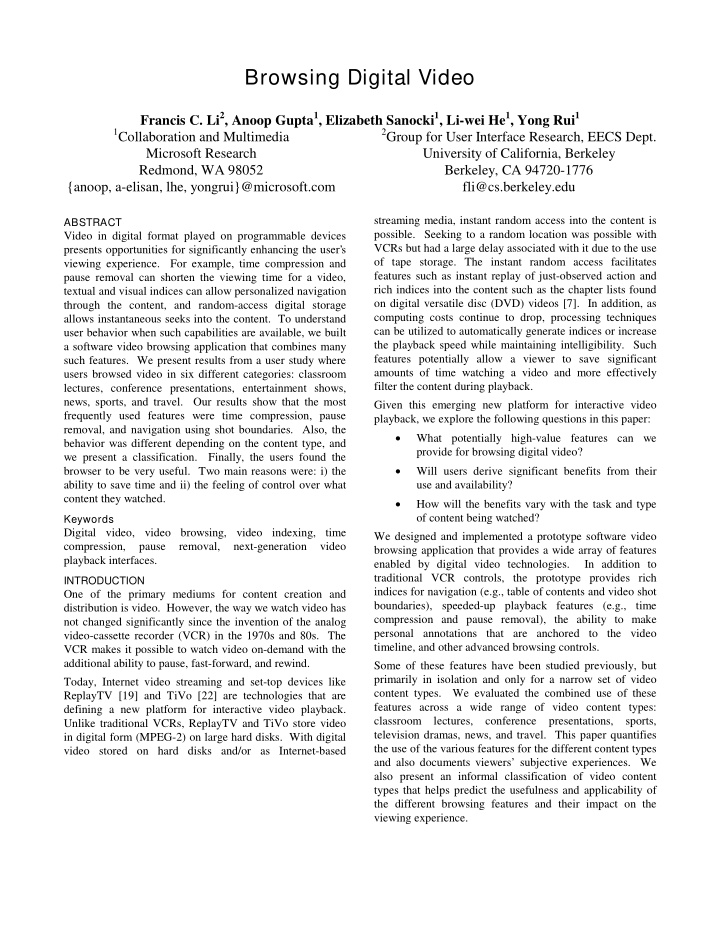



Browsing Digital Video Francis C. Li 2 , Anoop Gupta 1 , Elizabeth Sanocki 1 , Li-wei He 1 , Yong Rui 1 1 Collaboration and Multimedia 2 Group for User Interface Research, EECS Dept. Microsoft Research University of California, Berkeley Redmond, WA 98052 Berkeley, CA 94720-1776 {anoop, a-elisan, lhe, yongrui}@microsoft.com fli@cs.berkeley.edu streaming media, instant random access into the content is ABSTRACT possible. Seeking to a random location was possible with Video in digital format played on programmable devices VCRs but had a large delay associated with it due to the use presents opportunities for significantly enhancing the user’ s of tape storage. The instant random access facilitates viewing experience. For example, time compression and features such as instant replay of just-observed action and pause removal can shorten the viewing time for a video, rich indices into the content such as the chapter lists found textual and visual indices can allow personalized navigation on digital versatile disc (DVD) videos [7]. In addition, as through the content, and random-access digital storage computing costs continue to drop, processing techniques allows instantaneous seeks into the content. To understand can be utilized to automatically generate indices or increase user behavior when such capabilities are available, we built the playback speed while maintaining intelligibility. Such a software video browsing application that combines many features potentially allow a viewer to save significant such features. We present results from a user study where amounts of time watching a video and more effectively users browsed video in six different categories: classroom filter the content during playback. lectures, conference presentations, entertainment shows, news, sports, and travel. Our results show that the most Given this emerging new platform for interactive video frequently used features were time compression, pause playback, we explore the following questions in this paper: removal, and navigation using shot boundaries. Also, the What potentially high-value features can we behavior was different depending on the content type, and �� provide for browsing digital video? we present a classification. Finally, the users found the browser to be very useful. Two main reasons were: i) the Will users derive significant benefits from their �� ability to save time and ii) the feeling of control over what use and availability? content they watched. How will the benefits vary with the task and type �� of content being watched? Keywords Digital video, video browsing, video indexing, time We designed and implemented a prototype software video compression, pause removal, next-generation video browsing application that provides a wide array of features playback interfaces. enabled by digital video technologies. In addition to traditional VCR controls, the prototype provides rich INTRODUCTION indices for navigation (e.g., table of contents and video shot One of the primary mediums for content creation and boundaries), speeded-up playback features (e.g., time distribution is video. However, the way we watch video has compression and pause removal), the ability to make not changed significantly since the invention of the analog personal annotations that are anchored to the video video-cassette recorder (VCR) in the 1970s and 80s. The timeline, and other advanced browsing controls. VCR makes it possible to watch video on-demand with the additional ability to pause, fast-forward, and rewind. Some of these features have been studied previously, but primarily in isolation and only for a narrow set of video Today, Internet video streaming and set-top devices like content types. We evaluated the combined use of these ReplayTV [19] and TiVo [22] are technologies that are features across a wide range of video content types: defining a new platform for interactive video playback. classroom lectures, conference presentations, sports, Unlike traditional VCRs, ReplayTV and TiVo store video television dramas, news, and travel. This paper quantifies in digital form (MPEG-2) on large hard disks. With digital the use of the various features for the different content types video stored on hard disks and/or as Internet-based and also documents viewers’ subjective experiences. We also present an informal classification of video content types that helps predict the usefulness and applicability of the different browsing features and their impact on the viewing experience.
Recommend
More recommend